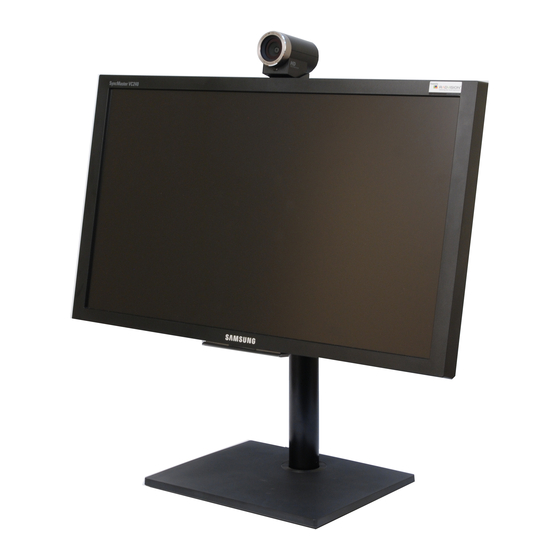
Table of Contents
Advertisement
Quick Links
Advertisement
Table of Contents

Summary of Contents for RADVision SCOPIA VC240
- Page 1 APPENDIX 01/11 TEST RESULTS FOR RADVISION SCOPIA® VC240 Manufacturer: RADVISION Model: SCOPIA® VC240 Software Version: Optional Features and None Modifications: 11th – 15th April 2011 Date of Test: 720p High Definition Camera SCOPIA® VC240 System...
- Page 2 Remote Control...
-
Page 3: Table Of Contents
C O N T E N T S Page No. A: INTRODUCTION ............1 B: SETUP PROCEDURE ............1 C: HARDWARE DESCRIPTION ..........2 D: SYSTEM OPERATION ..........8 E: VIDEO TESTS SUMMARY ..........10 AUDIO TESTS SUMMARY ..........10 G: CONNECTIVITY ..............10 Appendix 1 Detailed Physical Information ........13 Appendix 2 Detailed Video Tests …………........ -
Page 4: A: Introduction
INTRODUCTION The RADVISION SCOPIA® VC240 is a self contained High Definition (HD) videoconferencing system with a picture resolution of 1280 x 720 pixels (720p). The system comprises a 24” monitor, CODEC, camera with integral microphone and loudspeakers integrated into a single desktop unit. Compatibility with other H.323 and SIP CODECS is achieved across a range of resolutions from CIF (352 x... -
Page 5: C: Hardware Description
HARDWARE DESCRIPTION General This compact standalone system requires no additional equipment for basic conferencing. Where data sharing is required a PC or laptop computer may be connected and there are provisions for an external microphone and headphones. The CODEC will establish connections up to a maximum bandwidth of 2 Mbit/s and delivers a peak image resolution of 720p at 30 frames per second. - Page 6 Full screen of the far end image with near image Picture in Picture (PIP) Far and near image side by side Large far image, small near image Picture outside Picture (POP)
- Page 7 The “Source” button on the remote control selects either the PC (analogue PC input/ DVI input) or the VC (conferencing CODEC output) to be displayed on the picture monitor. To preview the computer output during a videoconference or to use the system as a PC monitor when not in a call, either PC or DVI are selected.
- Page 8 H.239 Call, large presentation image, small near and far images, Transmit End * Presentation and far images side by side Full screen presentation with far image PIP...
- Page 9 Remote camera zoom control is listed as a feature but was not functioning with other vendors’ products. RADVISION confirmed that this feature is to be supported in later software versions A PC may be directly connected to the CODEC via the DVI-D or the analogue VGA inputs.
- Page 10 All audio input and output connections are presented on industry standard 3.5mm mini-jack. Encryption is not supported by the SCOPIA® VC240. RADVISION confirmed that this feature is to be supported in later software versions.
-
Page 11: D: System Operation
D: SYSTEM OPERATION The system is limited to set up and control via the infra-red remote control. The on- screen menus are both logical and easy to use. System setup menu The “Source” button on the remote control selects the input to the display screen from the VC (CODEC) output or either of the PC analogue or digital sources. - Page 12 An H.239 connection is initiated and terminated through the remote control using the single Presentation source button: Pressing this button for a short period selects the computer presentation source and starts the H.239 link. Pressing the button again for a short period terminates the H.239 link. The camera occupies one channel and the source connected to either PC input the second channel.
-
Page 13: E: Video Tests Summary
VIDEO TESTS SUMMARY A basic videoconference between two SCOPIA® VC240 systems produced very good results at 720p resolution. During an H.239 conference the high resolution PC images were restricted, however, by the low frame rate of 2-3 frames per second. This restricts the type of material that can successfully be shared. - Page 14 Connectivity with Other Machines (models listed with comments) H.323 Successful connections were made in each direction with the following CODECs. Where the systems supported H.239, presentation material was also shared. CODEC Call Resolution Resolution Model and Software Bandwidth Transmitted by Received by Version the SCOPIA®...
- Page 15 H.239 issues In general, where XGA content at a resolution of 1024x768 was transmitted by a third party CODEC or MCU to the SCOPIA VC240, the SCOPIA reported receiving 1024x720 pixels and the presentation image was cropped vertically. This effectively removed both the taskbar and the blue bar at the top of the shared application.
-
Page 16: Appendix 1 Detailed Physical Information
Appendix 1 Detailed Physical Information Dimensions: (w x h x d) 57 x 44 x 23 cm Analogue RGB Connector Video Inputs Analogue Y Pb Composite/YC Digital Main camera Internal connection PC input Analogue RGB 15 pin D type PC Input Digital DVI-D The DVI-D input does not support High Definition Content Protection (HDCP). -
Page 17: Appendix 2 Detailed Video Tests
Mobility The SCOPIA® VC240 system can be moved easily. To establish a connection, each new location will need the local area network information re-entered into the configuration menu. Appendix 2 Detailed Video Tests The SCOPIA® VC240 includes analogue PC and DVI-D inputs which may only be transmitted via the H.239 second channel at 2-3 frames per second, sharing the available bandwidth with the main camera.
















Need help?
Do you have a question about the SCOPIA VC240 and is the answer not in the manual?
Questions and answers